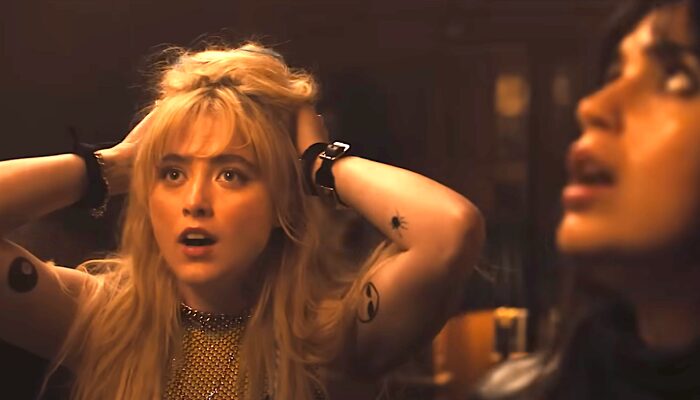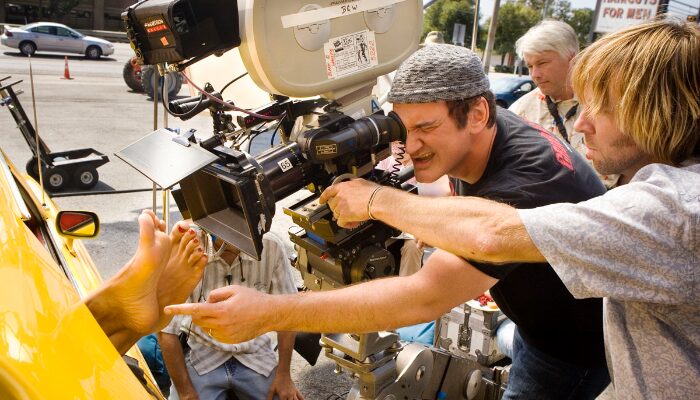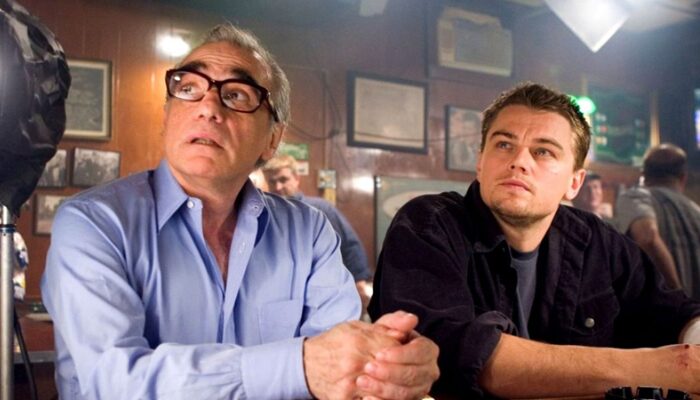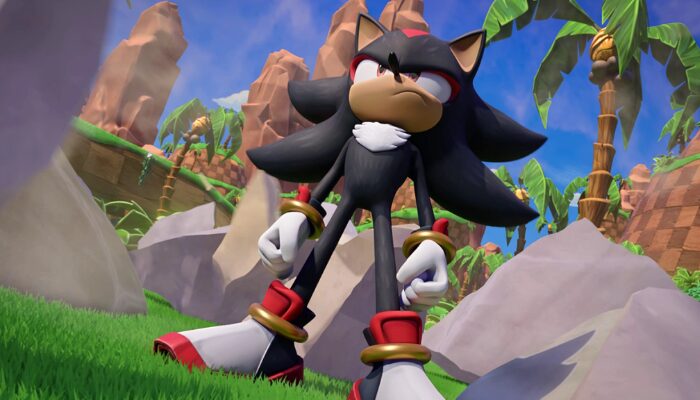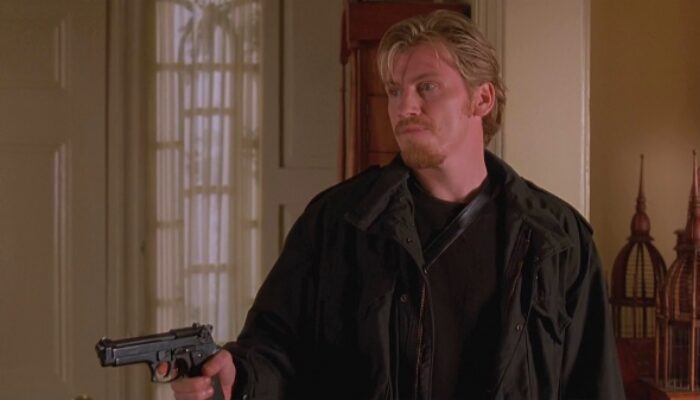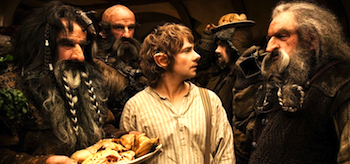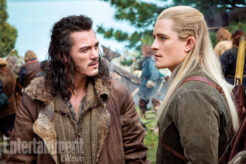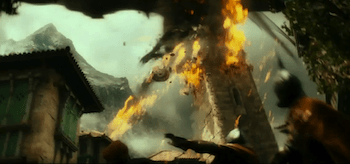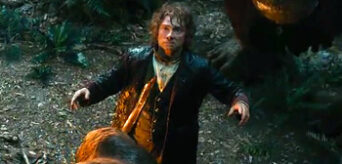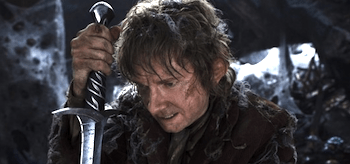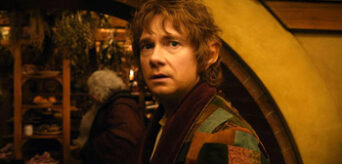Film Review: THE HOBBIT: AN UNEXPECTED JOURNEY (2012): Peter Jackson
The Hobbit: An Unexpected Journey (2012) Film Review, a movie directed by Peter Jackson and starring Martin Freeman, Ian McKellen, Cate Blanchett, Christopher Lee, Sylvester McCoy, Ian Holm, Elijah Wood, Andy Serkis, Manu Bennett, Lee Pace, Benedict Cumberbatch, Barry Humphries, John Rawls, Richard Armitage, Graham McTavish, Ken Stott, Aidan Turner, Dean O’Gorman, Mark Hadlow, Jed Brophy, Adam Brown, John Callen, Peter Hambleton, William Kircher, James Nesbitt, Stephen Hunter, Bret McKenzie, Kiran Shah, Jeffrey Thomas, and Michael Mizrahi.
The Hobbit: An Unexpected Journey‘s beginning was not as galvanizing or as entertaining as the films in The Lord of Rings trilogy, especially The Fellowship of the Ring and The Return of the King.
The opening Erebor scene seemed too long (as was the later Cave Troll scene), the Bilbo Baggins (Ian Holm)/Frodo Baggins (Elijah Wood)’ moments were plain, and the dwarf introductions were far too self-indulgent. All four were symptoms of the two original Hobbit films being stretched into three films.
The dwarves’ intro scene in particular should have been cut down. The dwarves were singularly introduced yet the viewer learned nothing of their personalities from the scenes. They were a waste of time, dull, and should have been condensed. Some said this type of character/scene indulgence was present in Jackson’s King Kong. I did not notice it in that film but did in Quentin Tarantino‘s Kill BIll: Vol. 2, perhaps the most analogous situation to the dwarf introductions. Marginal characters and situations were given far more screen time in Kill BIll: Vol. 2, like in An Unexpected Journey, than they would have if the film had remained one film like it was originally intended to be. In both cases, it hurt the films but in An Unexpected Journey, it dispersed any momentum the film had going into that scene.
Doubt played a big part in The Hobbit: An Unexpected Journey, as Thorin Oakenshield (Richard Armitage) continuously doubted Bilbo’s ability to perform adequately on their quest. Bilbo, in turn, questioned his own self-worth and actions. Oakenshield’s apprehensions about Bilbo were all valid and Bilbo knew that, whether Thorin spoke of them openly or Bilbo covertly overheard them. This was the beginning of both of their character arcs in the film and as both arcs began with each other so did they end with each other.
The past and present were used to an excellent degree in Thorin’s story arc and Bilbo’s morals were put to a great test after his wits were during his arc. Azog the Defiler (Manu Bennett) was a surprising villain and a worthy foil to Thorin. Their first confrontation (The Battle of Azanulbizar) would have made a far better beginning to An Unexpected Journey than Smaug taking Erebor and damaging the town of Dale (though it did lead to something beneficial). Thorin’s dislike of elves made the film better. It brought real-world prejudice into a fantasy world but not without a firm foundation.
The Riddles in the Dark scene was excellent from beginning to end, as was what followed it: (Spoiler) Bilbo deciding not to kill Gollum (Andy Serkis). (End Spoiler) The conflict on his face during that moment and the emotion on Gollum’s face were a perfect ending to their scene. At its outset, the scene showed just how far CGI and its capabilities had improved since The Lord of The Rings trilogy had been released. The viewer could see the veins in Gollum’s arms and the shine of light off his eyes. The riddle contest that ensued later in the scene was more enjoyable than most of the battles that An Unexpected Journey housed. It was the “PO-TA-TOES” moment from The Lord of the Rings: The Two Towers expanded to a flawless degree. I read The Hobbit years ago so I do not remember if all of those riddles were directly from the book or a if a few were invented specifically for the film. Either way, each and every one was enjoyable to hear and try to figure out before the on-screen characters did. Also enjoyable was seeing the stakes rise as the riddle contest proceeded: the threat of mortal combat and death were always present.
Another scene where death and combat went hand-in-hand was the Goblin Town scene. The best dialogue in the scene belonged to the Great Goblin (Barry Humphries) but other goblins in the scene had their brief moments as well (e.g. the goblins’ fear of elvish swords Foe-hammer and Goblin-cleaver). The ending to the Goblin Town scene was idiotic: (Spoiler) the Great Goblin asked Gandalf the Gray (Ian McKellen), who was armed with Foe-hammer, “what will you do now?” while completely left open to attack. It was an absurd moment and absurd writing. It was obvious what was going to happen, that happened, and the film moved on beyond that ludicrous and ineffectual plot point without a second thought. (End Spoiler) A king and warrior who was smart enough to rise to the level of ruler would never do such a thing. It was comedic and anti-climatic instead of dramatic and daring. It was a waste of a potentially formidable villain and it was a waste of a scene that had accelerated in grandeur up to that point.
The scale of The Hobbit: An Unexpected Journey was assisted by information from various appendices and The Silmarillion. All were put to front and back-story use during various moments in this The Hobbit film, none more so than with the inclusion of Radagast the Brown (Sylvester McCoy). This was one of the few moments in the film where the extra screen time afforded characters because of the two Hobbit films becoming three actually ameliorated the proceedings (e.g. his trip to Dol Guldur).
The Hobbit: An Unexpected Journey, unlike The Lord of the Rings films that proceeded it, was a film of highs (e.g. the fire tree sequence) and lows (e.g. Smaug waking up underneath the gold). The viewer can only imagine how much tighter and concise this film would have been if The Hobbit had remained two films instead of being stretched into three films. God help us if there is an extended edition for this film. That would hurt the film even further.
Rating: 8/10
Related Articles
FilmBook's Newsletter
Subscribe to FilmBook’s Daily Newsletter for the latest news!

